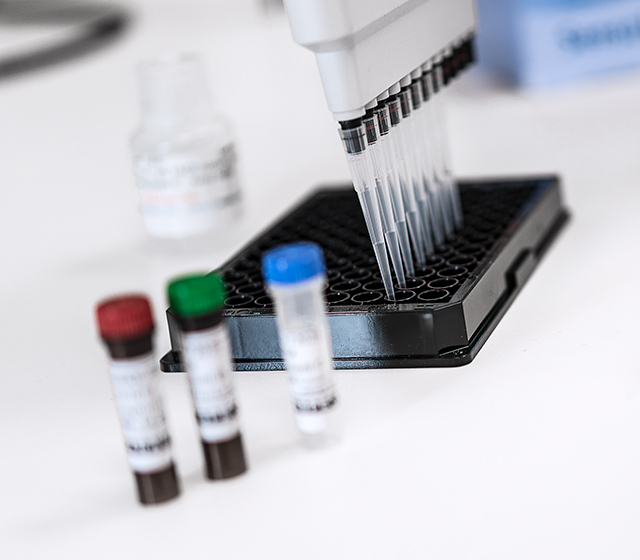Diabetes & Metabolism
Enterokinase
Enterokinase also known as enteropeptidase is a membrane-bound enzyme serine protease that initiates the activation of pancreatic hydrolases by cleaving and activating trypsinogen and converting it into trypsin and has a specificity for the sequence (Asp)4-Lys-Ile. Enterokinase is produced by cells of the duodenum and its absence results in intestinal digestion impairment. Enterokinase also plays an important role in the development of pancreatitis. SensoLyte ® Enterokinase Assay Kits are the ideal tools for use in biochemical applications.
β-Glucocerebrosidase
β-Glucocerebrosidase is a member of the glycoside hydrolase family. It is an enzyme with glucosylceramidase activity that cleaves glucocerebroside which is important in glycolipid metabolism. Glucocerebrosidase is localized on cell membranes and is also associated with lysosomal membrane. Glucosylceramides were detected within lamellar bodies and in trans-Golgi network-like structures of the stratum granulosum. Mutations in the glucocerebrosidase gene cause Gaucher's disease, the most prevalent lysosomal disorder, due to a deficiency of glucocerebrosidase. It leads to the accumulation of glucosylceramide in cells of mononuclear-macrophage lineage. Bone disorder in Gaucher disease produces defects on bone metabolism and structure. Also, a chronic stimulation of the immune system is a hallmark in this disease. The SensoLyte® Glucocerebrosidase (GBA) Assay Kits detect GBA activity.
Diabetes mellitus
Diabetes mellitus is a group of metabolic disorders characterized by chronic hyperglycaemia with disruptions of carbohydrate, fat and protein metabolism caused by malfunction in insulin secretion and action. AnaSpec offers a collection of SensoLyte® assay kits associated with this disease.
One of the proteases related to diabetes is Insulin-degrading enzyme, also known as IDE, or insulin protease, a zinc metallopeptidase that degrades intracellular insulin, and consequently terminates insulin’s activity. It also regulates the levels amyloid β-protein, amylin, and some other peptides. Distorted IDE’s activities may lead to type 2 diabetes mellitus and Alzheimer’s disease. IDE represents potential therapeutic target for diabetes drug discovery.
Dipeptidyl peptidase-4 (DPP IV), also known as adenosine deaminase complexing protein 2 or CD26 is an enzyme expressed on the surface of most cells. Among other activities, DPP IV is important for the initial inactivation and degradation of GLP-1, a potent antihyperglycemic peptide hormone that induces glucose-dependent stimulation of insulin secretion. Screening for DPP IV inhibitors is important in type 2 diabetes research.
Calpains are nonlysosomal intracellular cysteine proteases expressed ubiquitously in mammals and other organisms. Calpains activity ultimately depends on the presence of calcium. The precise mechanism of calpains action remains to be elucidated, however it is known that they are involved in normal calcium-dependent activities and pathological conditions including diabetes, cancer, atherosclerosis, muscular dystrophy, etc. suggesting that High Throughput Screening of protease activity and protease inhibitors may be of particular interest for researchers of these diseases.
Neprilysin
Neprilysin (NEP) is a neutral endopeptidase, a zinc-dependent metalloprotease that inactivates several peptide hormones. This is a widely expressed enzyme with broad substrate specificity. Scientific data shows that mammalian neprilysin has several potential peptide targets involved in regulating neuronal function, appetite, metabolism, energy homeostasis and inflammation.
Recent studies show that human neprilysin functions as a transmembrane “ectoenzyme” that cleaves neuropeptides that regulate glucose metabolism and has been linked to type 2 diabetes. Data from several studies in humans support the use of neprilysin inhibitors in the prevention and treatment of type 2 diabetes.
Another example of neprilysin activity is its role in Alzheimers Disease (AD). Neprilysin is a major Aβ-degrading enzyme, and its levels are decreased in AD brains and during aging. NEP downregulation may contribute to the pathophysiology of AD.
Neprilysin is also a common acute lymphocytic leukemia antigen that is an important cell surface marker of human acute lymphocytic leukemia (ALL). In cancer research, the NEP is recognized as CD10 or CALLA.
AnaSpec constantly expands the selection of SensoLyte® Diabetes related assay kits employing FRET or other technologies that make High Throughput Screening of protease activity, protease inhibitors and inducers accurate and fast.
FRET substrates
FRET occurs between a peptide tagged to a donor and an acceptor when placed within 10-100Å of each other resulting in the donor’s excitation fluorescence to be quenched by the acceptor. Enzymatic hydrolysis of the peptide results in recovery of the donor fluorescence following spatial separation of the donor and acceptor upon energy transfer.
| Dye (donor) | Quencher (acceptor) | Donor Ex/Em | |
| SensoLyte® 390 | Mca | Dnp |
•
325/393 nm |
|---|---|---|---|
| SensoLyte® 490 | EDANS | DABCYL |
•
340/490 nm |
| SensoLyte® 520 | 5-FAM or HiLyte™ Fluor 488 | QXL®520 |
•
494/521 nm |
| SensoLyte® 570 | 5-TAMRA | QXL®570 |
•
547/574 nm |
Fluorogenic substrates
These substrates do not require a quencher and contain a C-terminal dye that does not fluoresce until it is cleaved from the peptide (fluorescent form of dye is released).
| Dye (donor) | Donor Ex/Em | |
| SensoLyte® AMC | AMC |
•
351/430 nm |
|---|---|---|
| SensoLyte® AFC | AFC |
•
382/480 nm |
| SensoLyte® Rh110 | Rh110 |
•
501/527 nm |
